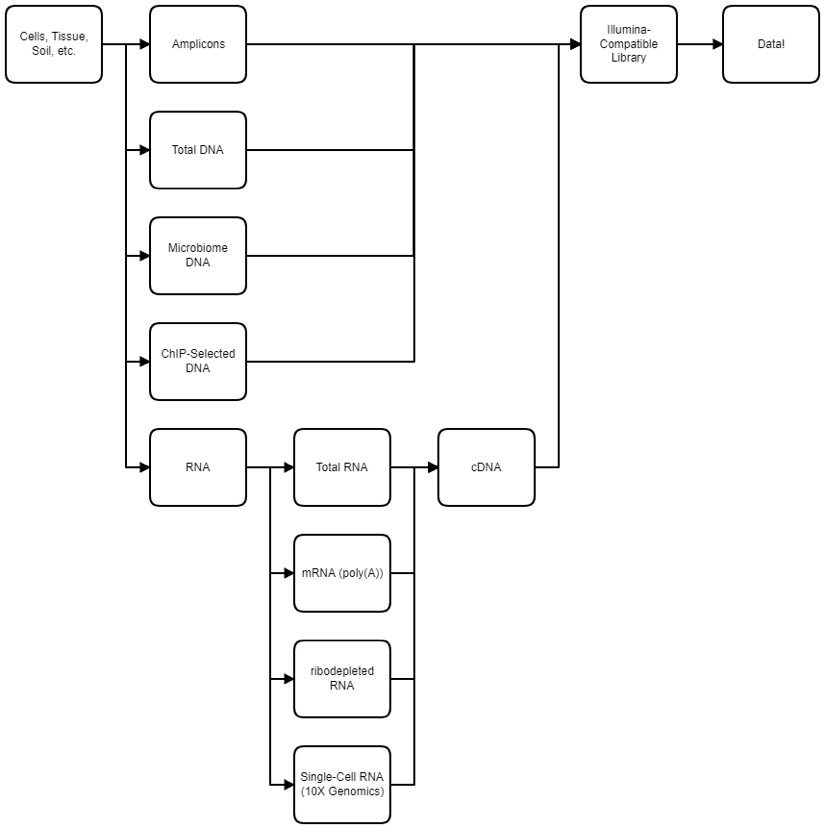As the field of genetics and genomics grows, sequencing protocols and technology must address an incredibly wide (and ever-increasing) range of source types and sequencing foci. In light of this, the ASU Genomics Facility has standardized and optimized multiple commonly-used workflows, as illustrated in the following diagram, and is additionally able to assist researchers with other more specialized options.
The following diagram shows a simplified progression of biological material from the original source to the final sequencing data, containing the samples types we most frequently encounter at the Genomics Facility. Additional details about each step in that progression follow.

Source Material: DNA can be harvested from a myriad of sources. The facility is able to assist with RNA and DNA extraction from cultured cells, frozen tissue, FFPE tissue, insects, soil, stool samples and more. If you have a more unusual sample type we may be able to provide assistance even if we are not equipped to do the extraction ourselves.
DNA: The diagram shows the types of DNA we encounter most frequently at the facility. Other than the microbial targets listed below, DNA selection will need to be performed before submitting your sample to the facility if total DNA is not right for your project. Amplicons should be between 150 and 1000bp for sequencing to be successful.
Microbial DNA: For microbiome studies, we are able to prepare barcoded libraries for the following gene targets:
- 16S gene (515f-806r) for Bacteria/Archaea[i]
- 16S gene (515f-806r) for Bacteria/Archaea[ii][iii]
- 16S gene (515f-926r) for Bacteria[ii][iv]
- 18S gene (1391f-EukBr) for Eukaryotes[v]
- ITS Internal Transcribed Spacer (ITS1f-ITS2) for Fungi[vi]
RNA: We are able to sequence total RNA (the best option for samples with very low amounts of RNA or degraded RNA), pull down mRNA using poly(A) selection, or remove ribosomal RNA prior to sequencing. Because ribosomal RNA can differ by species, less standard species may require additional time to complete. We also now offer single-cell RNA sequencing using the 10X Genomics platform, which separately tags RNA from each cell before combining them for library preparation and sequencing.
Sequencing Libraries: While we offer library preparation beginning from any of the earlier steps in the diagram, researchers are also able to construct their own sequencing libraries to submit to the facility. These libraries must contain Illumina adapters in order for us to sequence them –feel free to contact us if you are unsure whether or not your libraries are compatible. All libraries, whether built in the faciliuty or not, are thoroughly QC’d prior to sequencing with qPCR and the Agilent Tapestation.
Data: The final product of a successful sequencing workflow is, of course, the data! In conjunction with the Bioinformatics Facility, we offer demultiplexing and conversion to fastq files with each run, as well as a number of other standard and specialized informatics pipelines for an additional fee. All data is returned via an FTP server for the fastest and most secure delivery possible. The informatics team is also to provide their expertise to help us address any questions or concerns you may have regarding completed projects and data.
Sanger Sequencing: Including PCR, plasmid, and pre-cycled big-dye reactions are run on the 3730XL DNA sequencer. The core has several standard sequencing primers available but please check these sequences with your vector sequence.
| Primer Name | Primer Sequence |
|---|---|
| M13 Forward | 5'-GTAAAACGACGGCCAGT-3' |
| M13 Reverse | 5'-CAGGAAACAGCTATGACC-3' |
| T7 | 5'-TAATACGACTCACTATAGGG-3' |
| T7 Terminator | 5'-TATGCTAGTTATTGCTCAG-3' |
| SP6 | 5'-CATACGATTTAGGTGACACTATAG-3' |
| T3 | 5'-AAATTAACCCTCACTAAAGG-3' |
i Caporaso, J. G., Lauber, C. L., Walters, W. A., Berg-Lyons, D., Lozupone, C. A., Turnbaugh, P. J., Noah Fierer, N., & Knight, R. (2011). Global patterns of 16S rRNA diversity at a depth of millions of sequences per sample. Proc Natl Acad Sci USA 108, 4516–4522.
ii Parada, A. E., Needham, D. M., & Fuhrman, J. A. (2016). Every base matters: assessing small subunit rRNA primers for marine microbiomes with mock communities, time series and global field samples. Environmental Microbiology, 18(5), 1403–1414
iii Apprill, A., McNally, S., Parsons, R., & Weber, L. (2015). Minor revision to V4 region SSU rRNA 806R gene primer greatly increases detection of SAR11 bacterioplankton. Aquatic Microbial Ecology, 75(2), 129–137
iv Quince, C., Lanzen, A., Davenport, R.J., & Turnbaugh, P.J. (2011) Removing noise from pyrosequenced amplicons. BMC Bioinformatics 12: 38. https://doi.org/10.1186/1471-2105-12-38
v Amaral-Zettler, L. A., McCliment, E. A., Ducklow, H. W., & Huse, S. M. (2009). A method for studying protistan diversity using massively parallel sequencing of V9 hypervariable regions of small-subunit ribosomal RNA Genes. PLoS ONE, 4(7), e6372
vi Smith, D. P., & Peay, K. G. (2014). Sequence depth, not PCR replication, improves ecological inference from next generation DNA sequencing. PLoS ONE, 9(2), e90234–e90234

